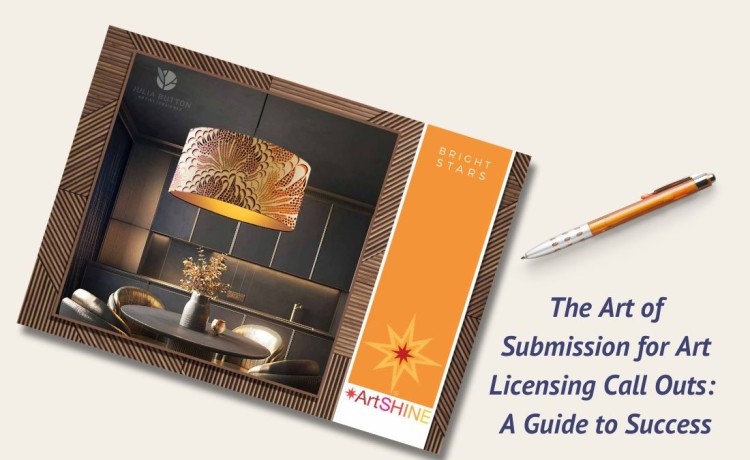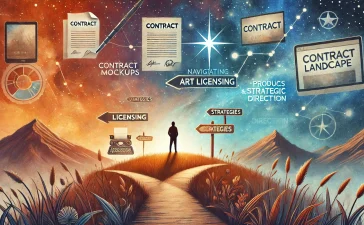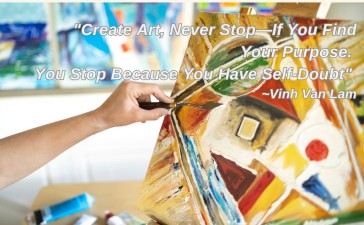ArtSHINE artist – Julia Button’s Brand book
In the vibrant world of art licensing, securing opportunities can be as much about your submission strategy as it is about your artistic talent. Whether you’re a seasoned professional or an emerging artist, mastering the art of responding to licensing call outs can significantly boost your chances of success. This article delves into six essential tips to help you navigate the submission process with finesse and increase your odds of catching a licensor’s eye.
- Decoding the Licensee’s Brief: The Foundation of Your Submission
The cornerstone of a successful art licensing submission lies in thoroughly understanding the licensee’s brief. This document is your roadmap, guiding you towards creating art that aligns perfectly with the company’s vision and requirements. Here’s how to approach it:
- Read, Re-read, and Reflect: Don’t skim through the brief once and dive into creation. Read it multiple times, allowing each detail to sink in. Pay attention to specific requirements, themes, and styles mentioned.
- Analyze the Mood Board: Many briefs include a mood board or examples of the art style they’re seeking. These visual cues are invaluable in understanding the aesthetic direction the licensee is aiming for.
- Interpret, Don’t Imitate: While the provided examples serve as inspiration, remember that your goal is not to replicate them. These designs already exist and copying them defeats the purpose of the call out. Instead, use them as a springboard for your creativity.
- Find Your Unique Angle: The challenge lies in creating art that fits the brief while showcasing your distinctive style. Look for ways to incorporate your unique artistic voice within the parameters set by the licensee.
By deeply understanding the brief, you set a solid foundation for creating art that resonates with the licensee’s vision while standing out from the crowd.
2. Timing is Everything: The Early Bird Advantage
In the world of art licensing submissions, procrastination can be your biggest enemy. Here’s why submitting early can give you a significant edge:
- First Impressions Matter: Many companies review submissions as they come in, rather than waiting until after the deadline. This “first in, first dressed” scenario means early submissions often receive more attention and consideration.
- Avoid Last-Minute Stress: Submitting well before the deadline allows you time to double-check your work, ensure all requirements are met, and make any necessary adjustments without the pressure of an imminent deadline.
- Demonstrate Professionalism: Early submission signals to the licensee that you’re organized, reliable, and enthusiastic about the opportunity – qualities that are highly valued in potential collaborators.
- Buffer for Technical Issues: Submitting early gives you a safety net in case of any technical difficulties or unforeseen circumstances that might arise during the submission process.
Remember, while quality should never be sacrificed for speed, finding a balance that allows you to submit high-quality work ahead of schedule can significantly boost your chances of success.
3 . Tailor Your Portfolio: Quality Over Quantity
When preparing your submission, it’s tempting to include as much work as possible. However, a carefully curated selection often proves more effective:
- Align with the Brief: Choose pieces that best represent your ability to meet the specific requirements outlined in the call out. This might mean creating new work or selecting existing pieces that closely match the desired style and theme.
- Showcase Versatility Within Boundaries: While staying true to the brief, try to demonstrate the range of your skills. This could include variations in composition, color schemes, or subject matter within the specified style.
- Present Your Best Work: Include only your strongest pieces. A few exceptional works will make a more lasting impression than a larger collection of average quality.
- Consider Commercial Viability: Remember that licensees are looking for art that will sell. Choose pieces that you believe have strong market appeal within the context of the brief.
By thoughtfully curating your submission, you demonstrate not only your artistic skills but also your understanding of the licensee’s needs and the market they’re targeting.
4. Pay Attention to Technical Requirements
Often overlooked, adhering to technical specifications can be the difference between your art being considered or immediately disqualified:
- File Formats: Ensure you’re submitting in the requested file formats. This might include high-resolution JPEGs for viewing or vector files for scalability.
- Color Modes: Pay attention to whether the licensee requires RGB (for digital use) or CMYK (for print) color modes.
- File Naming Conventions: Follow any specified naming conventions for your files. This helps licensees organize and locate your work efficiently.
- Metadata and Descriptions: If requested, include relevant metadata or descriptions for each piece. This can include titles, dimensions, or brief explanations of the artwork’s concept.
Meeting these technical requirements demonstrates your professionalism and makes it easier for licensees to review and potentially use your work.
5. Craft a Compelling Artist Statement
While your art should speak for itself, a well-written artist statement can provide valuable context and set you apart:
- Be Concise: Keep your statement brief and to the point. Licensees often review numerous submissions, so make every word count.
- Highlight Relevance: Explain how your style and experience align with the licensee’s needs. This shows that you’ve thoughtfully considered their brief and how your art fits their vision.
- Share Your Inspiration: Briefly discuss what inspired your submitted works, especially if it relates to the themes or concepts mentioned in the call out.
- Mention Past Successes: If relevant, briefly mention any past licensing experiences or notable achievements that demonstrate your understanding of the commercial art world.
Your artist statement is an opportunity to make a personal connection with the reviewers and provide context that enhances their appreciation of your submitted work.
6 . Present Your Submission Like a Pro
The presentation of your artwork is just as crucial as the art itself. A polished, professional presentation can make a significant difference in how your work is perceived and evaluated. Here’s why and how to elevate your submission:
- Go Beyond Basic PDFs: Avoid sending your submission as just a collection of images in a basic PDF. This approach lacks visual appeal and fails to showcase your work in the best light. Instead, invest time in creating a visually appealing presentation that reflects the quality of your art.
- Adhere to Agency Standards: If you’re working with an agency or licensing manager, they likely have established presentation standards. These standards are set for good reasons – they know what licensees expect and what makes a submission stand out. Adhering to these standards is crucial:
- It demonstrates your professionalism and attention to detail.
- It ensures consistency across all artists represented by the agency.
- It meets the expectations of licensees who are accustomed to a certain level of presentation.
- Don’t Rush the Presentation: In the excitement of completing your artwork, it’s tempting to hastily put together your submission. Resist this urge. A rushed presentation can undermine the quality of your work and create a poor impression.
- Meet All Requirements: Carefully review and fulfill all presentation requirements set by your agency or the licensee. This might include specific formatting, layout designs, or additional information to accompany each piece of art.
- Reflect Your Brand: Use the presentation as an opportunity to reinforce your brand. Consistent use of fonts, colors, and layout can help create a memorable impression.
- Include Necessary Context: Ensure your presentation includes all required information such as your name, contact details, artwork titles, and any specific details requested in the call out.
Remember, failing to meet presentation standards can have serious consequences:
- It reflects poorly on you as an artist, suggesting a lack of professionalism or attention to detail.
- It can damage your relationship with your agency, as it puts them in a difficult position when representing your work.
- In some cases, submissions that don’t meet standard requirements might not be submitted on your behalf at all, causing you to miss out on valuable opportunities.
By taking the time to present your submission professionally, you not only showcase your artwork in the best possible light but also demonstrate your commitment to quality and professionalism throughout your work process. This attention to detail can set you apart in a competitive field and increase your chances of success in the art licensing world.
Conclusion
Mastering the art of submission for art licensing call outs is a skill that can significantly impact your success in the industry. By deeply understanding the brief, submitting early, curating your portfolio thoughtfully, adhering to technical requirements, and crafting a compelling artist statement, you position yourself as a professional, attentive, and valuable potential collaborator.
Remember, each submission is an opportunity not just to showcase your art, but to demonstrate your professionalism, attention to detail, and understanding of the commercial art world. With practice and persistence, you can refine your submission process and increase your chances of turning those call out responses into successful licensing agreements.
In the competitive world of art licensing, your artistic talent is just the beginning. It’s your ability to effectively present that talent through strategic, well-crafted submissions that will ultimately set you apart and open doors to exciting opportunities in the industry
- Find out more
- Launch Pad + Accelerator Expressions of Interest
- Selling and Licensing Your Art & Designs Around the World with ArtSHINE.
- Looking for exciting new Art and Designs to license.
We’re here to help you to take action, just like we’ve helped thousands of other entrepreneurs, business owners, and creative professionals all around the globe.
Now is the time to let your passion SHINE.
Now is the time to Make Tomorrow Today!
To your success, Vinh Van Lam and Stuart Horrex Cofounders ArtSHINE.com





